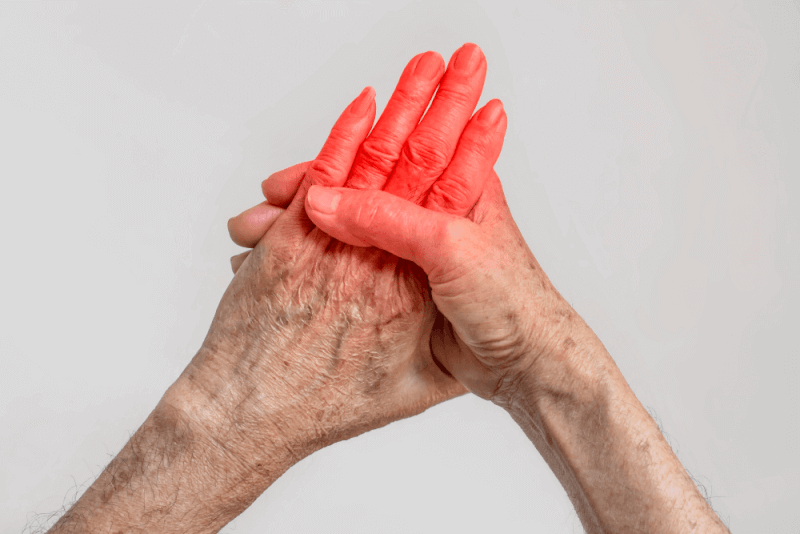What is Fibromyalgia (Soft Tissue Rheumatism)?
Fibromyalgia is a long-term (chronic) health condition that causes pain and sensitivity. It causes musculoskeletal pain and fatigue. People with fibromyalgia often experience symptoms that come and go during periods of exacerbation. Living with this disease can be exhausting and challenging. Fibromyalgia can also make you feel tired and cause symptoms such as memory problems.
It is a chronic soft tissue rheumatism that causes pain in muscles and bones and disrupts sleep patterns. Experts don't know what causes fibromyalgia, but research suggests that certain health conditions, stress and other changes in your life are among the triggers. If a family member has fibromyalgia, you may be genetically predisposed and more likely to have fibromyalgia.
What are the Medicines for Fibromyalgia?
Medications usually used in fibromyalgia; painkillers such as acetaminophen may be recommended by your doctor. In cases of extreme pain, some medicines that can be obtained with a special prescription can also be used. These drugs are used in minimal doses and for short periods of time to reduce addiction and side effects.
Antidepressant medications are sometimes used to treat the anxiety and depression associated with fibromyalgia. These drugs also improve sleep quality and reduce chronic pain.
Apart from medication, the patient must exercise. In addition to the treatment of soft tissue rheumatism, activities such as relaxation movements, cardiovascular conditioning, walking at a slow pace, swimming and cycling should be practiced to prevent the disease. The patient should avoid things that can affect sleep. They should not drink alcohol, cigarettes, tea, cola, coffee. In physical therapy applications, hot application and massage with pain relieving devices give positive results. Sea, sand, sun and swimming are very good for the disease.
What triggers a fibromyalgia flare-up?
Certain situations and changes, events in your life can trigger a fibromyalgia flare-up. In some people, the conditions that trigger the disease may not be the same as yours.
In general, flare-ups can be triggered by situations that increase your stress. For example, emotional stress related to your work, financial situation and social life, changes in your daily routine, changes in your diet, lack of adequate and regular nutrition, hormonal changes, lack of adequate and quality sleep, changes in weather and temperature, getting sick and starting different medication or treatment can all contribute to a flare-up.
Fibromyalgia Symptoms
Fibromyalgia is a chronic disease characterized by widespread pain throughout the body. In addition, the symptoms seen in fibromyalgia patients include the following.
Widespread pain
The pain felt by fibromyalgia patients is spread throughout the body. For this pain to be considered a symptom of fibromyalgia, it must affect both sides of the body. In addition, the pain should be seen both above and below the waist. The pain caused by fibromyalgia is particularly intense in areas such as the neck and back. In addition, the pain must persist for several months and be aching and throbbing.
Rigidity
As with other rheumatic diseases, fibromyalgia is also characterized by rigidity. Stiffness and stiffness occur especially after patients have been in the same position for a long time. Stiffness can cause restricted mobility in patients, especially when getting out of bed in the morning or getting up from the table after a meal.
Hypersensitivity
Another symptom of fibromyalgia is that patients develop sensitivity to pain. For this reason, patients may feel pain even when the pain is too mild to be felt, and the duration of pain after minor trauma may be prolonged.
Muscle spasms
Patients with fibromyalgia often experience muscle contractions, accompanied by pain and tenderness.
Fatigue
One of the most common symptoms of fibromyalgia is fatigue. The severity of fatigue seen in patients varies, ranging from mild fatigue symptoms to severe fatigue symptoms that can cause disruption of daily work.
Deterioration of sleep quality
Fibromyalgia leads to shortened periods of deep sleep, which is necessary for the body to regenerate. For this reason, even if patients sleep for a long time, they may wake up in the morning feeling restless. Patients may also experience symptoms such as lack of energy, weakness, distraction and inability to focus due to the deterioration of sleep quality due to the disease.
Cognitive problems
Another problem seen in fibromyalgia patients is cognitive problems. Patients may experience impairments in functions such as memory formation, learning and thinking. The blurred mental structure of patients also causes them to experience problems such as slow speech.
Feeling extremely hot or cold
Another symptom caused by the disease is that it causes problems in regulating body temperature. For this reason, patients may perceive the heat as too cold or too hot.
Symptoms in Women
Fibromyalgia, which is more common in women, causes more negative consequences in women in terms of symptoms. Pain is more common in women, and morning fatigue related to symptoms such as restless leg syndrome is also more common in women. It can be said that monthly menstruation in women is more painful. However, the transition to menopause can also worsen fibromyalgia symptoms.
Symptoms in Men
Fibromyalgia, which is more commonly known as a women's disease, often manifests in men as a lot of pain and emotional problems. In men, fibromyalgia has recently become easier to diagnose and more men are being diagnosed with fibromyalgia as the diagnosis has become more common.
Other symptoms
In addition to the above-mentioned symptoms, fibromyalgia brings some health problems along with it, and these health problems include the following.
- Salt foot syndrome
- Chronic headache
- Painful menstruation
- Depression
- Painful bladder syndrome
- Restless bowel syndrome
- Anxiety
Causes of Fibromyalgia
The exact cause is not known, but certain genes you inherit from your family may genetically increase your risk of developing fibromyalgia. By looking at the links between parents and children, it can be diagnosed that the disease runs in families. People with fibromyalgia are more sensitive to pain. Experts also think that genetic mutations in the genes that signal pain in the brain can cause fibromyalgia, although they have not established an exact link. There are some risk factors for the development of fibromyalgia. People over 40 are more likely to have fibromyalgia. But it can occur in many people, including children. Fibromyalgia is 2 times more common in women than in men. People with chronic diseases, osteoarthritis, depression, anxiety disorders, chronic back pain and irritable bowel syndrome are more likely to have fibromyalgia. This disease can occur in people who have had an infection. People who have experienced a lot of stress, physical or emotional trauma or serious injury can also develop fibromyalgia. The factors that cause people to suffer from chronic pain in fibromyalgia syndrome are still poorly understood. Some theories suggest that, depending on various factors, the brain lowers the pain threshold or that what was not painful before becomes very painful over time. Some individuals may overreact to pain signals.
Fibromyalgia Diagnostic Methods
First of all, for the diagnosis, the patient's anamnesis is taken and a physical examination is performed by a specialist physician. Symptoms, pain and its distribution in the body are important for diagnosis. Some tests, muscle and joint examinations are then performed. During the physical examination, the neck, neck, waist, elbow, chest, hip, shoulder and knee areas are examined in detail. Diagnosis is often part of the differential diagnosis. Through a medical process of elimination, your doctor will make a diagnosis based on a comparison of symptoms related to several conditions.
Fibromyalgia Treatment Methods
The aim of the treatment of fibromyalgia syndrome is to minimize the complaints and symptoms and to improve the quality of life. The medications prescribed by your doctor, changes in lifestyle and other care methods are very important during this disease process. Medicines used for pain relief may help to improve the quality of your sleep. Painkillers for severe or mild pain are among the medicines used for fibromyalgia. Depressants are available for regular sleep and chronic fatigue.
Supportive and complementary herbal medicines and natural treatment methods may also be involved in the treatment process. In addition to traditional medicines, alternative natural therapies should be used as supportive to reduce pain and stress. Spa therapy, meditation, yoga, yoga, physical therapy, massage therapy, a healthy and balanced diet program will support the treatment. In addition to treatment, exercises such as aerobics, strengthening, stretching and relaxation are among the exercises that benefit fibromyalgia. Successful results will be obtained with these exercises performed three to four times a week for half an hour.
Fibromyalgia exercises
The reason why exercise is so important for fibromyalgia patients is to increase the amount of oxygen delivered to the muscles. Because fibromyalgia is a disease caused by insufficient oxygenation of the muscles.
It is important to gradually increase the intensity of the exercises to be performed by fibromyalgia patients. In addition, a special exercise program to develop the muscles in the area of pain should be prepared by professionals.
Fibromyalgia physical therapy
Physical therapy, which has an important place in the treatment of fibromyalgia, helps to control the pain. For this, the following are among the points that physical therapists especially emphasize.
- Compression to relieve pain and make the muscles more flexible
- Reducing the mesh by stretching the muscles and making the muscles more tense
- Use of manual therapy techniques to relieve pain in muscles and other connective tissues
- Dry needling to reduce pain by applying thin wire-like apparatus to painful areas
- Applications of various massage methods to increase blood flow to tissues, relieve stiffness in muscles and promote relaxation
- Electrical stimulation depending on the severity of the pain
What should fibromyalgia patients pay attention to?
Fibromyalgia, which usually occurs between the ages of 20 and 55, affects 5% of the world's population. As it is a chronic disease and its treatment is symptomatic, it is extremely important that patients learn to live with it. Among the points that fibromyalgia patients should pay attention to in order to lead a better quality life are the following.
Learning about life with fibromyalgia
Fibromyalgia patients primarily need to make lifestyle changes. It is extremely important for patients to accept that fibromyalgia is chronic and to live a life at peace with their disease in order to improve their quality of life. Patients are discouraged from judging or blaming themselves as this may increase the symptoms of the disease. On the other hand, with appropriate treatment and self-care, it is possible to control very severe fibromyalgia complaints.
Monitoring of drug therapy
The first point that fibromyalgia patients should pay attention to in order to improve their quality of life is to follow their medication regularly. The correct dosage and frequency of medication recommended by the patient's doctor plays a key role in controlling symptoms. In addition, patients should be careful about the side effects of medicines and should consult their doctor in case of any side effects.
Stress reduction
As with many other diseases, the stress factor is also a contributing factor to the aggravation caused by fibromyalgia. It is therefore extremely important that patients learn to cope with stress. For this, patients are recommended methods that reduce stress levels, such as meditation, yoga or deep breathing exercises. In addition, patients need to make time for themselves in their daily lives and make sure they get enough rest.
Exercise
One of the indispensable parts of fibromyalgia treatment is exercise. Because the symptoms of fibromyalgia may be exacerbated in people with reduced physical activity levels and their general health may be negatively affected. For this reason, it is extremely important for patients to determine a regular exercise program and stick to it. They need to pay attention to their physical commissions and pain tolerance when determining their exercise program. For this reason, yoga, walking, aquatic exercises and light aerobics are generally recommended for fibromyalgia patients.
Good sleep habits
If fibromyalgia patients gain quality sleep habits, it is extremely easy to manage the symptoms caused by the disease. Even small changes in sleep quality cause patients to feel more weakness, fatigue and pain. For this reason, patients need to optimize their sleep environment, sleep position and sleep routines so that they wake up feeling better in the morning. For this, patients are advised to follow a regular sleep schedule. For a better quality of sleep, routines such as a moderate massage, a relaxing warm bath, stretching exercises, yoga or listening to calming music can be established before bedtime. In addition, dark and quiet bedrooms and optimal room temperature help to improve the quality of sleep.
Foods consumed
Another issue that fibromyalgia patients should pay attention to is their nutrition. Because the symptoms of fibromyalgia are influenced by food. It is therefore recommended that patients keep a food diary to keep track of how they feel after their meals. In this way, it can be discovered which nutrients are linked to the symptoms caused by the disease. In addition, foods such as fresh vegetables and fruits, anti-inflammatory foods, fibrous whole grains, Omega 3 fatty acids help to reduce the symptoms caused by fibromyalgia.
Smoking, alcohol and caffeine
Fibromyalgia patients should avoid smoking and alcohol because cigarette smoke reduces the amount of oxygen in the blood, nicotine is a stimulant and alcohol causes inflammation in the body and therefore increases pain symptoms. Since caffeine plays an important role in the deterioration of sleep quality, it is one of the foods that patients should not consume.
Probiotics
Recent research on fibromyalgia suggests that the gut microbiota is linked to the chronic pain caused by the disease. In addition, some abnormalities related to serotonin metabolism have been detected in fibromyalgia patients. For this reason, patients' intestinal microbiota regulation by eating a probiotic-rich diet and thus increasing serotonin production helps to reduce the pain caused by the disease.
The healing power of water
Mineral waters, especially hot water pools, thermal baths and hot tubs are known to relieve the pain and fatigue caused by fibromyalgia, reduce muscle tension, reduce inflammation and provide general relaxation. In patients who regularly benefit from the healing power of water, there is a significant decrease in anxiety and depression symptoms frequently seen in fibromyalgia patients, as well as an increase in sleep quality. For this reason, warm baths for 20-30 minutes 3 days a week will help alleviate the symptoms.
Dance and music
Dance and music therapies recommended for fibromyalgia patients help to reduce both physical and emotional stress. It also helps patients to increase body awareness and relax their muscles. For this reason, it is strongly recommended that fibromyalgia patients take dance classes or play a musical instrument.
Psychological support
Since fibromyalgia is one of the chronic diseases and affects serotonin metabolism, it is known that patients are often depressed. Psychological support is recommended to prevent this. In particular, patients who participate in support groups fight the psychological effects of the disease better because they do not feel alone.
Physical therapy programs
It is extremely important for fibromyalgia patients to go for regular medical check-ups, as this helps to prevent the development of possible health problems or to detect them at an early stage. In addition, by continuing physical therapy programs that reduce muscle spasms and increase blood flow, the pain felt by patients is significantly reduced. For this reason, it is extremely important for patients to participate in specially planned physical therapy programs and to continue their medication.
What are the pain points in fibromyalgia?
When patients consult a doctor with suspected fibromyalgia, doctors apply pressure on some parts of the patient's body during the physical examination. The appearance of pain in these areas allows patients to be diagnosed. These points, called sensitive points, are nine each on the right and left side of the body. The sensitive points, 18 in total, are symmetrically located. This is why fibromyalgia is considered to be the only symptom of character. The locations of fibromyalgia points are as follows.
- Inside of the knee
- Inside and side of the elbow
- The area just below the point where the collarbone meets the ribs is also the site of the second rib
- The outer region of the upper leg, called the greater trochanter, where the hip meets the foot
- The upper outer region of the buttocks, called the gluteal
- The part of the body bone called the supraspinatus near the middle of the body and the trapezius point
- Upper back
- Nape
What happens if fibromyalgia is not treated?
If fibromyalgia is left untreated, the severe and chronic pain and fatigue felt by patients can significantly affect their daily lives. As the aggravation of symptoms caused by fibromyalgia causes patients to limit their physical activities, their quality of life is negatively affected.
Fibromyalgia attacks
Although fibromyalgia patients struggle with chronic pain for a significant part of their lives, the course of the disease also includes periods of attacks when pain and other symptoms are more severe. Among the factors that can trigger fibromyalgia attacks are the following.
- Stress
- Infection
- Physical activity
- Air exchange
- Hormonal changes
- Sleep changes
- Exposure to extreme heat or cold
- Traveling
- Change of treatment regimen
Although the experience of fibromyalgia attacks varies according to the patients, the complaints seen in patients during the attack period include the following.
- Aggravation of pain
- Significant deterioration of sleep quality
- Significantly reduced quality of life
It is also possible to make changes in the treatment of patients during the attack period of fibromyalgia. During this period, exercise, medication and alternative treatment options are recommended. Patients are prescribed painkillers, antidepressants and muscle relaxants. In addition, exercise will reduce the severity of pain and help patients to improve their sleep quality. The most preferred alternative treatment options are massage and acupuncture applications.
Coping with the complaints caused by fibromyalgia attacks can be challenging for patients. However, managing the stress in their lives and communicating with their physicians about their attacks can make them more comfortable.
How long do fibromyalgia attacks last?
The duration of fibromyalgia attacks varies between patients and is also related to the severity of the causative factor. For this reason, fibromyalgia attacks can pass within a few days or last for several months or weeks.
Fibromyalgia and diet
It is extremely important for patients to determine a correct diet in order to reduce and control the symptoms caused by fibromyalgia. In addition to the main nutritional values, vitamins and minerals should also be included in the diet of patients. However, calorie adjustments of the selected foods should also be made. Otherwise, patients may experience weight gain. The fact that fibromyalgia patients are above their ideal weight causes the symptoms to worsen. In order for all these to affect the lives of patients in a good way, it is recommended that nutrition programs are prepared by specialist physicians.
Nutrients for muscle growth
In order to control the pain of fibromyalgia patients, it is extremely important that their muscles develop correctly. However, instead of using weights to develop their muscles, patients should do this with proper nutrition and exercise programs suitable for patients. The main nutrients that will support the development of patients' muscles include the following.
Red meat
The protein in red meat is extremely valuable in the formation and strengthening of muscle structure. Red meat, which has the strongest protein value among protein-containing foods, is recommended to be consumed 1 to 2 times a week.
Chicken and fish
Although chicken meat does not contain as much protein as red meat, it is a valuable source of protein for muscle development. In addition, the amino acids in fish meat enable the protein to be used in muscle formation. For this reason, it is extremely important for muscle nutrition.
Milk products
The protein in milk binds perfectly with other types of protein. In this way, it strengthens the structure of the muscles. In addition, it supports physical development thanks to the amino acids it contains. For this reason, it is recommended to consume at least 1 serving of milk and dairy products during the day.
Nuts
Nuts contain amino acids as well as important minerals such as magnesium, potassium, iron and calcium. These minerals are extremely important for body regeneration and support muscle growth.
Green plants
The protein in arugula, purslane, spinach, broccoli, onion and other green vegetables plays an important role in the development of the body. Vegetables help muscles to become their best.
Is fibromyalgia cancer?
Fibromyalgia is not a form of cancer. It is also not related to soft tissue or muscle rheumatism, although these are often confused.














